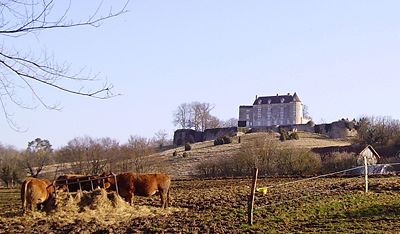- Château de Montréal
-
The Château de Montréal is a château in the Dordogne department located near the commune of Issac, in southwestern France. It overlooks the valley of the Crempse River.
The château, was built in the 12th century and rebuilt in the 16th century. It is classified as an historical monument of France[1]. It is now a private residence.
Contents
History
Claude de Pontbriand, the Seigneur de Montréal, accompanied the French explorer Jacques Cartier on his expedition up the Saint Lawrence River, and was with him on October 3, 1535, when he reached a village of the Iroquois Indians called Hochelaga, on the site of the present day city of Montreal.
The Pontbriand family built the château in its current form. They also built the chapel Sainte-Épine[2] They modernized the double walls of the ramparts, which are very well preserved. and add the Renaissance style facade of the residence. The house is open for visits in summer- it is possible to visit the salons, which have a collection of portraits, and the circular library in the tower.
The Gardens
The gardens were built upon the ramparts of the fortress at the beginning of the 20th century by Achille Duchêne. The lower garden is in the Italian style, and features hibiscus and yew trees, and walls covered with white roses and white clematis. The upper garden is a Garden à la française, with ornamental flower beds and a topiary garden. The garden was badly damaged by a storm in 1999, and has been replanted. The gardens are classified by the Committee of Parks and Gardens of the Ministry of Culture as one of the Notable Gardens of France.
See too
References
- ^ French Ministry of Culture: Château de Montréal (French)
- ^ The chapel is classified an historic monument, and shelters the reliquary of la Sainte-Épine, taken from the body of the British general John Talbot, killed at the Battle of Castillon in 1453. Talbot's heroic death was described by William Shakespeare in his play Henry IV.
Categories:- Châteaux in Dordogne
- Gardens in Dordogne
- Official historical monuments of France
Wikimedia Foundation. 2010.

